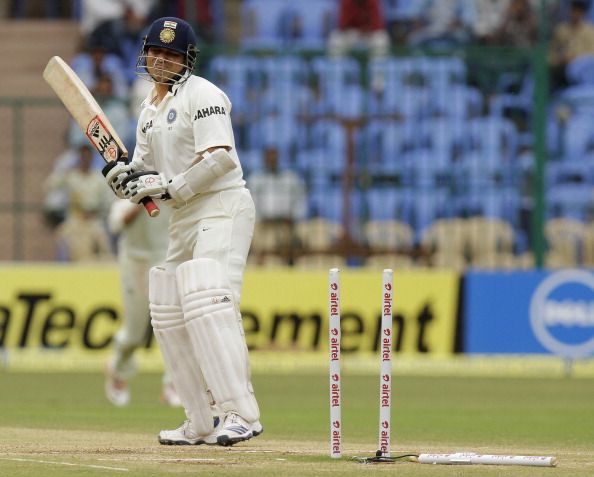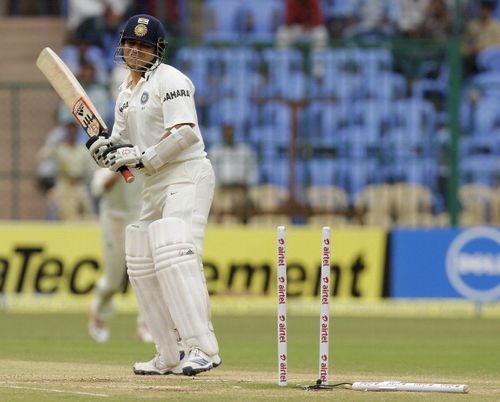
Sachin should say Goodbye

It’s hard to say how it is but Sachin Tendulkar’s bat always seems broader than everyone else’s. To see him in studious defence is to have the full face of his blade etched in your mind: the MRF logo (now Adidas), the red (or white) ball marks, mostly at it’s centre, and, if it is well worn, you will notice the indentation at the sweet spot, willow slightly sunken after thumping ball after ball after ball. It almost seemed like his blade is broader than his pads, wider than the stumps, even wide enough for a door perhaps. It just seems so wide.
Their difficulty in getting past his bat, I’m sure, has led bowlers to form the same impression. It must have been distressing for them to see their best efforts against India’s Little Master so often come to naught. Australian batsman of the 1930’s and journalist Jack Fingleton, had this to say of Donald Bradman:
It is not difficult to believe that bowlers’ thoughts of Bradman were hard ones. Imagine yourself as Tate, Mailey, or Ironmonger. What would your thoughts of Bradman be? If you had spun the flesh off your fingers; if you had planned and sweated for aching day after day until your shoulders were heavy and your heart despondent; if you had done all this and seen your honest offerings treated with the smile of contempt… (Cricket Crisis, p.34.)
While nobody has even come close to matching the dominance of Bradman, Tendulkar has come the closest, of modern batsmen, to giving bowlers an inkling of what it must have been like to go up against the incomparable Australian. Over the 22 years that the man from Mumbai has been the bane the world’s bowlers, he has scored a hundred international centuries: 51 in tests at an average of 56.16, and 49 in ODIs, at 44 83. Ricky Ponting, who is next on the list, has 29 fewer.
But though his figures are staggering there can be little doubt that his formidable powers have been on the wane. Pakistani legend Imran Khan recently suggested that Tendulkar should leave the game at his peak. It might be ill advised to disagree with one who has achieved so much in the sport, but it is unwise for athletes to leave while at the top of their game. The time to go is when they are in decline.
That the great one is past his best is hardly in dispute. Tendulkar has not scored a test hundred since his 146 at Cape Town against South Africa in January 2011. In the four series he has played since, he has averaged over 40 only once; while only once did he average less than 50 in the 9 series that preceded the 2010/11 tour to South Africa. And apart from his painstaking century against Bangladesh, which took him to his hundredth international hundred, his recent 50-over returns have not been spectacular either.
One more thing to consider is that India currently has an army of talented batsmen to inject into the side. And with a long stretch of home encounters scheduled before the side travels abroad, now is a good time to get them involved. As VVS Laxman said upon announcing his retirement: “I think it’s the right time to give opportunity to the youngsters in home conditions before obviously the tough overseas tours next year.” It might just be time for Tendulkar’s thoughts to wander in a similar direction.
It is often difficult for superstar performers to withdraw from the field of battle. From the time he was a boy, cricket has consumed most of Tendulkar’s waking hours (and probably a lot of his sleeping ones as well) and it won’t be easy to walk away. History is replete with examples of elite sportsmen who compromised their reputations by playing on for too long: Muhammad Ali, Babe Ruth, Michael Jordan, Willie Mays, Wally Hammond–the list goes on. The greatest competitors are often the last ones to accept that their skills are fading. Frequently, it has to be pointed out to them, and this process sometimes ends up being a messy affair—better for the man to leave on his own terms. Imran Khan is at least right about one thing: Tendulkar should not leave his fate in the hands of the selectors.
Mind you, one should always be careful in suggesting that India’s heartbeat should pack it in. Many were made to eat their words after expressing that he should end his career during his poor run from around 2004-2007–only for him to storm back with the most productive period of his career. The difference today is that he is 39 years old. Even the best of us have to surrender to the dictates of time.